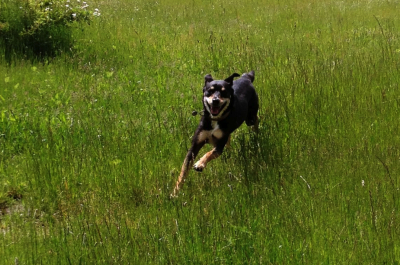A simple bit of training that could save your dog's life
 Friday, July 12, 2013 at 3:34PM
Friday, July 12, 2013 at 3:34PM  How much would you be willing to bet that your dog will come immediately when you call her from across your living room? A hundred dollars? Twenty? Would you bet ten dollars that she’ll come when you call her in from your back yard? What if there are squirrels around? Would you bet a dime that your dog will turn on a dime after he’s bolted toward the street in pursuit of your neighbor’s cat? More to the point, would you bet your dog’s life?
How much would you be willing to bet that your dog will come immediately when you call her from across your living room? A hundred dollars? Twenty? Would you bet ten dollars that she’ll come when you call her in from your back yard? What if there are squirrels around? Would you bet a dime that your dog will turn on a dime after he’s bolted toward the street in pursuit of your neighbor’s cat? More to the point, would you bet your dog’s life?
Words like “come” and “here” are known to trainers as “recall” cues, and there are many good reasons that a truly reliable recall is often referred to as the PhD of training. First and perhaps most importantly, the times when we need these cues most are the times when they’re least likely to work: when our dogs are off-leash and free to ignore us in favor of a wide-open and very exciting world.
It’s hard enough for a shouted “Come!” or “Here!” to compete with the attractions of other dogs, or field mice, or horse manure, but we unfortunately shoot ourselves in the proverbial foot all the time when we lose track of what those words actually mean to our dogs. We may think they refer to a behavior that a dog “knows” how to perform: return to me now. In a dog’s mind, however, they often mean trouble ahead. We’ll call our dogs inside when we need to leave, or call them at the park when we want to leash them up. When “come” so often predicts the end of good times, we shouldn’t be surprised that it sometimes sends our dogs running away.
This is why I continually encourage my students and clients to “put money in the bank” when it comes to training “come.” Training is all about channeling the power of habit, and good habits of association help create and support good habits of behavior. For every time that we associate “come” with impending confinement or boredom, there should be fifty times that we associate it with delicious treats or a new opportunity to play. The more good associations you’ve invested in your cue, the more you can spend when you need to.
That said, it’s almost inevitable that our everyday recall cues will get poisoned with some negative associations. This is where an emergency recall cue can “come” to the rescue! What follows is some of the easiest but potentially most powerful training you can do, and it’s all about creating a purely positive habit of association:
1. Choose a simple but unusual word or phrase that’s short and easy to say but not something you’d use in ordinary conversation. Foreign words can work well here, and so can silly ones. Examples include “¡Arriba!” and “Treat party!”
2. Prepare and set aside 10 - 15 small pieces of something that your dog finds incredibly delicious.
3. Use your everyday cue (like “here”) to call your dog over. This will add to your pile of good associations, since your dog is about to receive many wonderful treats for doing little or nothing!
4. Say your emergency cue: “¡Arriba!”
5. Pause briefly.
6. Deliver a treat.
7. Repeat until the treats are gone.
8. Do this once or twice a day for two weeks. Try varying your tone to include both more and less cheerful and more and less urgent repetitions of the cue. Be careful to build your intensity gradually to make sure that you don't scare your dog! Your aim is to have your dog thrill to the sound of your emergency cue no matter what tone you use.
9. After two weeks, continue to build the power of your cue by using it at random times, but only when you’re ninety-percent sure your dog will respond to it, and only when you’re prepared to reward your dog with at least five delicious treats, delivered one-by-one, with a new repetition of the cue before each treat.
10. You can train your emergency cue as much as you like; the more positive associations you load into it, the stronger it will be. To keep those associations pure and powerful, only use your emergency cue in case of emergency.
That’s it! Give it a try and see whether your dog soon makes a whiplash turn when he hears your secret phrase. You can use the same simple method to strengthen his positive response to your everyday recall cue, or to his name.
One last piece of advice regarding recall cues in general: avoid using them if you’re not willing to make at least a five-dollar bet that they’ll work, since every unsuccessful repetition weakens the cue. Only give your dog as much freedom as you’re confident she can handle, and when in doubt, go get her yourself rather than waste your most precious words.


Reader Comments (1)
I read your blog you take on this topic is well-written and original. I want to get more information about this, hope you continue to keep up with this. Your information is so impressive and useful for us.